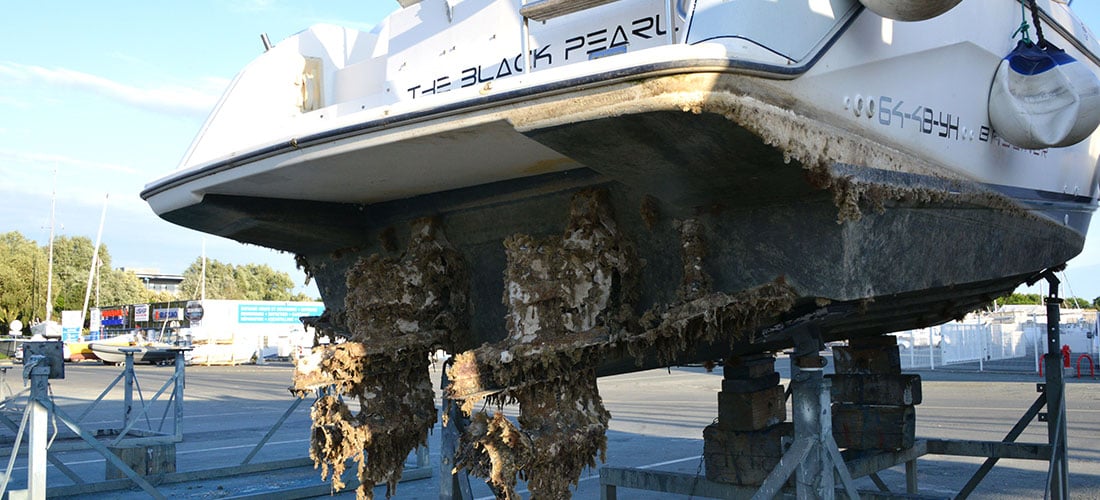Antifoulings and the environment… A complex future!
Since then, having owned several boats myself, I have watched our industry go through the contortions of a love / hate affair with the dreaded smelly, sticky and rather expensive stuff, which is more likely to start a heated discussion in the yacht club bar than almost any other boat related subject!
Lets face it; it’s a poisonous potion that we’d rather not have to apply below our water lines, but we are consumed with dread about the consequences for our boats if we don’t do it regularly and properly. I’ve never met anyone who really enjoys doing their antifouling, although professional contractors might enjoy spending the money it earns them! And anyone who loves the sea, and its natural inhabitants, can never really be comfortable with introducing any form of toxicity into the marine environment.
However, as always, there are two sides to the argument, and this comes across very clearly in an advisory article recently published by the RYA in conjunction with the British Coatings Federation.
The basic facts about anti fouling
The article starts off by confirming what most of us are highly aware of, which is quoted verbatim as follows: ‘Biocidal antifouling paints are hazardous mixtures that function by preventing the build-up of marine organisms on the hulls of commercial ships and pleasure craft of all sizes. Antifouling paints work largely by releasing biocides into the water, thus preventing organisms from attaching themselves to the bottom of boats.’
‘Whilst this is good for keeping the hull clean, improving efficiency through the water and preventing the spread of invasive non-native species, it does mean that some of the toxic ingredients leach into the water. Increased concentrations of copper can sometimes be found in the sediment around lift out points in estuaries and rivers and can find their way into the food chain causing a wide range of environmental problems.’
What could change?
The RYA / BCF article argues that the future quality and availability of antifouling paints in Europe, in particular for application to leisure craft, is now in some doubt. This is due to the requirement for all biocidal products to undergo a stringent authorisation procedure under the Biocidal Products Regulation (EU) No.528/2012 (BPR).
Now, whilst this may seem like a good protective measure for the ocean environment, there are counter arguments that it could also have considerable negative effects if the legislation is taken too far.
For instance, two other substantial threats to our future environment are excessive carbon emissions, and the spread of invasive species that upset the natural balance of biodiversity. The article warns that reduced effectiveness of antifoulings, which could come about due to ‘overkill’ on controlling biocides, would result in increased carbon dioxide emissions, and proliferation of invasive species.
So, a detrimental affect on the environment could be the result, and this would very likely be accompanied by a negative economic and social impact in the recreational boating sector, due to a fall in boat ownership numbers. The very last thing our industry needs!
Antifouling application in the spotlight
In 2015 the British Coatings Federation carried out the most comprehensive survey ever undertaken on the DIY use of antifouling paints in the UK. This was partly in reaction to suggestions from EU regulatory authorities that only professional contractors should undertake antifouling applications.
Encouragingly, the results found that more than 90% of boat owners were taking the correct precautions, but the survey highlighted several areas for improvements. These included the provision of training courses, better guidance on preparing the boat and disposing of waste paint, and further efforts that could be made to minimise the risks of skin contact with antifouling paint during its application.
The BCF launched an educational awareness campaign earlier this year, in order to improve the knowledge level of how to apply antifouling safely, and with environmental responsibility. The initiative has been fully supported by the RYA and other boating organisations, and it features a concise 5-minute video, which can be viewed here:
They also produced this handy reference leaflet highlighting the do’s and don’ts to be observed when carrying out your antifouling work.
Alternatives to antifouling
All in all, it’s hard to see how antifoulings can be avoided, and I guess they are not about to disappear any time soon, but understandably there are more alternatives being developed. Maybe not to replace them completely, but to help reduce the frequency of application.
One of them, which is gaining traction, is the Utrasonic antifouling method, which doesn’t rely on chemicals that can harm fish and mammals or pollute the air, and can reduce vessel lift-outs for cleaning.
Another interesting development is the introduction of underwater hull cleaning drones or robots. As with the Ultrasonic systems there are more innovative players coming into the market and the technology is being continuously refined.
Obviously avoiding the lift out, and removing bio fouling before it gets too aggressively attached is a merit that such systems can possibly deliver, and we plan to cover their attributes in more detail in a future Community article.
Have your say…go on, pretend you’re in the yacht club bar!
Are you an antifouling friend or foe? Do you think that the future holds better solutions for avoiding bio fouling on boats? Do you think that biocides have to be tolerated to a degree?
Please share your knowledge, opinions and experiences using the below comment box.
Share your stories on leisure marine industry with us
Do you have an innovation, research results or an other interesting topic you would like to share with the leisure marine equipment industry? The METSTRADE website and social media channels are a great platform to showcase your stories! Let us know via metstrade@rai.nl
Are you a METSTRADE exhibitor?
Make sure you add your latest press releases to your Company Profile in the Exhibitor Portal for free exposure.





.jpg?h=400&iar=0&w=1200)
